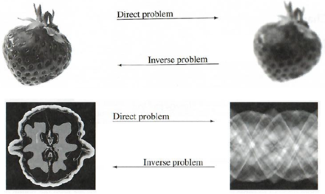Inverse problems

Problems with Practical Applications. Philadelphia: siam.
How does an autonomous vehicle recognize a traffic sign? How can seismic measurements be used to determine the origin of an earthquake? How can a three-dimensional tomographic reconstruction of a body part be obtained from a medical scanner?
The methods for answering all these questions originate from the field of so-called inverse problems and are of central importance for our society. They are omnipresent in technology, science and also in everyday life and contain mathematics - without many people being aware of it. The process of mathematical modelling is used to solve inverse problems. Complex problems are simplified in such a way that mathematical models can be developed and then accurate solutions can be calculated. Now the question arises whether it is also possible for high school students to use their mathematical school knowledge and computer skills to work on such complex problems and independently find accurate solutions.
In the case of inverse problems, one tries to obtain information about an unknown object by using inaccurate, indirect data. Typically, this data is generated by a phenomenon of physics. If small errors in the data cause huge errors in the object, it is called an ill-posed inverse problem. Therefore, the three conditions of Hadamard must be checked:
- Existence: At least one solution should exist.
-
Uniqueness: There should be at most one solution.
-
Stability: The solution should always depend on the data.
This is exactly where this research project starts. The aim is to reduce these problems didactically in such a way that they are also accessible to high school students and can be solved in a one-day workshop. School mathematics should be applied in the mathematical methods required for this in order to enable direct integration into (interdisciplinary) school teaching. In addition, solving these real problems shows authentic applications of school mathematics, which are still often missing from current textbooks.
Computer tomography
The reconstruction of an image in computed tomography represents such an ill-posed placed inverse problem. Computer tomographs are used to check whether bones or organs were injured in an accident or whether a patient has a tumour. The patient is irradiated with X-rays and the doctors receive an image of the cross-section of the examined body part. Different grey tones represent different materials, which attenuate the rays to different degrees through absorption.
The central question of the workshop is: "How is it possible to obtain images of the inner structure of the radiographed body parts with the help of X-rays?